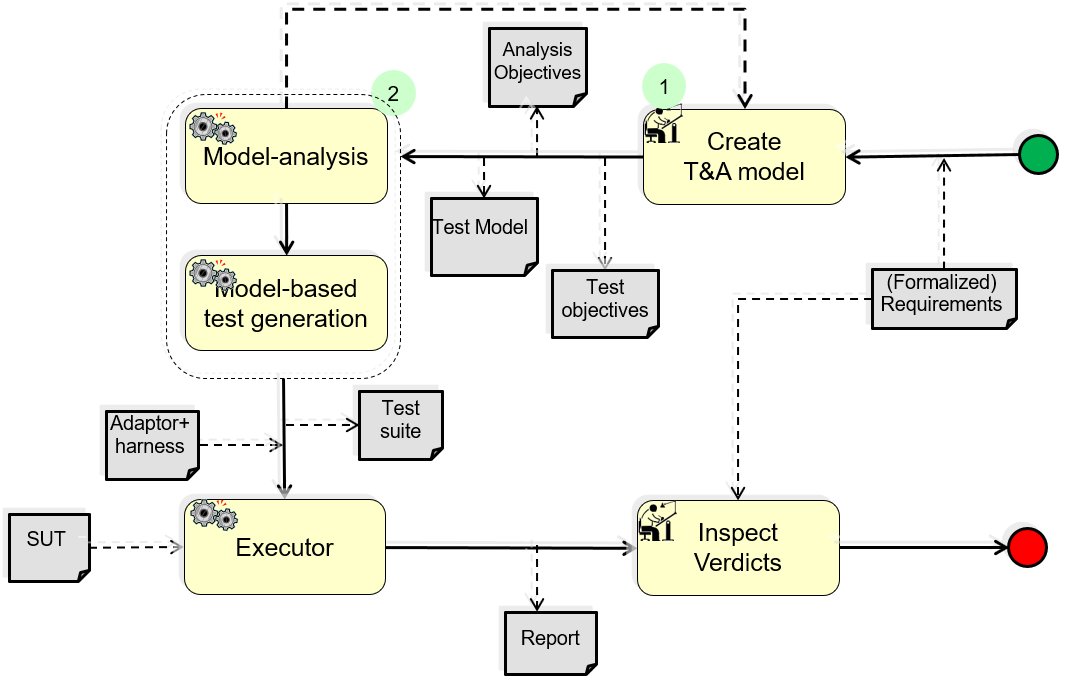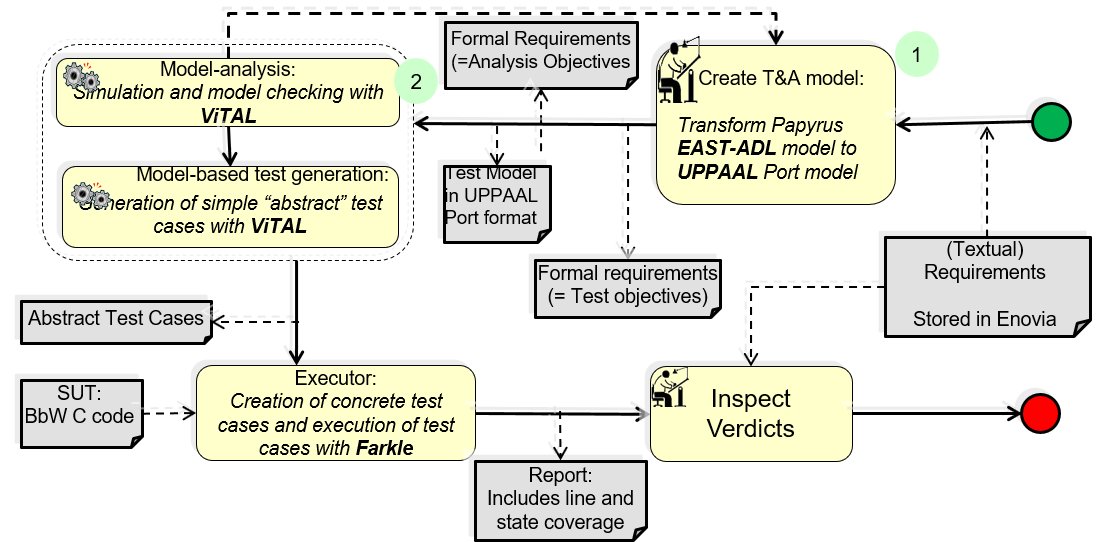MBT with Test Model Analysis
Meta-Information
Origin: Brian Nielsen / Aalborg University, completed by Wolfgang Herzner / AIT
Written: July 2014
Purpose: Increase confidence in generated tests by analysing (model-checking) the model from which tests are generated (valid tests that satisfy requirements, failing tests likely caused by wrong implem.).
Context/Pre-Conditions: Model-based test case generation (MBTCG) is used as described by pattern ‘MBT’.
To consider:
– It depends on chosen modelling language/notation how easy and efficiently this pattern can be applied.
– Test (modelling) experts need some expertise in model checking.
.
Structure

Participants and Important Artefacts
Only those are described here that operate in addition to those described in pattern ‘MBT’.
Analysis objectives: Properties that have to be possessed by the test model. They are derived from requirements by the T&A model engineer, and should be formulated such that they can be proven by model checking. Additional properties are generic checks like alle edges/locations reachable, abscense of deadlocks.
Model analyser: Process that examines whether the test models meets the analysis objectives. A typical technique used here is model checking.
.
Actions / Collaborations
Only those are described here that operate in addition to those described in pattern ‘MBT’.
(1) The T&A model engineer defines the analysis objectives from the requirements, perhaps in cooperation with the customer.
(2) The model-analyser is usually a model checking process (controlled by a human expert) that examines the model whether it meets an objective or it find a counter example (path through the model) that violates the objective.
.
Discussion
Benefits: Successfull checking of analysis objectives increases trust in correction of subsequently generated test cases significantly. In particular:
– if a test case fails it can (most likely) be assumed that the implementation is wrong,
– if a test case passes confidence is high that the implementation actually conforms to the requirements.
Limitations:
– Model checking is expensive with respect to memory and CPU time, and may fail for more complex test models.
Comments:
– Of course, if model checking shows that the model violates an objective, it should be corrected. This is indicated by the dashed path in the structure diagram.
– If model checking fails for a certain analysis objective, AT-pattern “Use-test run to slice model” could help.
.
Application Examples
MBAT Automotive Use Case 1 (Brake by Wire) / Scenarios 2 (Analysis on the Analysis Model) and 5 (TCG based on Test Model)
Participants / Tools:
User: VOLVO
Tools: ViTAL (MDH); Farkle (Enea/XDIN/ALTEN)

MBAT Automotive Use Case 8 (Virtual Prototype Airbag ECU) / Scenarios 1-4:
Participants / Tools:
Analysis of Objectives
– The T&A model is checked for internal consistency with MoMuT::REQs.
– The T&A model, which was generated with UPPAAL, is verified against formal expressions entered by the verification engineer in order to validate this T&A model. Thereby also generic model properties like absence of deadlocks are analyzed.
Model Analysis
– MoMuT::REQs
– UPPAAL
MBAT Aerospace Use Case 4 (Flight Management System/UAV) / Scenarios 2 (Analysis and test for “system architecture” validation) and 3 (System testing validation):
Participants / Tools:
Create T&A model: Analysis Model: ALES FSV-BCL Toolbox, Test Model: ELVIOR TestCast Generator
Model Analysis: ALES FSV-Formal Verification
Model based Test Generator: ELVIOR TestCast Generator
Executor: ELVIOR Test Cast TTCN-3 (SC02) + AAEM Test environment (SC03)
Formalized requirements: SYSML requirement model: AAEM
Test model: SYSML statechart for POF functionality: AAEM
Test objectives: List of test criteria: ELVIOR TestCast Generator
Analysis objectives: List of derived requirements
Test suite: Selenium WebDriver
Adaptor+harness: TTCN3 functions: ELVIOR TestCast generator (SC02) + Executor to AAEM test environment adaptor: AMET (SC03)
SUT / Model generated executable: on host (C code): AAEM (SC02)
SUT / Real system executable: on OBMC board (C code): AAEM (SC03)
Report: Test results, analysis verdicts + counter examples: ALES + ELVIOR
MBAT Rail Use Case 1 (Automatic Train Control) / Scenario 2 (System Validation – Create and check T&A model):
Participants / Tools:
Create T&A model: MaTeLo Editor
Model Analysis: Model checking MaTeLo
Model based Test Generator: MaTeLo Editor & MaTeLo Testor
Executor: Mastria 200 Sol (In-house simulator)
Inspect Verdicts: ODEP + TARAM (In-house strip and analysis tools)
Comments: Model analysis is based on model checking function of MaTelo, it doesn‘t examine whether the test models meets the analysis objectives. It checks only some points, namely:
– The “Invoke” and “Terminate” state number.
– No outgoing transitions on the “Terminate” state.
– No entering transition on the “Invoke” state.
– A state is not a destination of duplicated transitions.
– For each profile chosen in the model checking, test if the sum of probabilities at the transitions leaving a state equals 1.0.
.
Relations to other Patterns
| Pattern Name | Relation* |
| MBT | This pattern complements (extends) MBT |
| Use Test Run to Slice Model | If the model is too large for analysis, that pattern can help to split test model such that parts can be analysed |
| Model and Refinement Checking | Both use same methods |
| MBA-Based Runtime Behaviour Verification | Also analyses the test model, but for generating test cases rather than for assuring model correctness |
* “this pattern” denotes the pattern described here, “that pattern” denotes the related pattern
